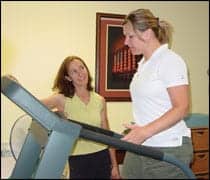For many, the notion of using exercise therapy to help individuals in their journey through cancer seems counterintuitive, especially for those currently in treatment. The general feeling has been that cancer and its treatment are so hard on the bod that adding the burden of exercise would not seem to be beneficial. Forty years ago, we thought the same thing about exercise and patients recovering from heart attacks. We are learning that like patients with heart disease, those with cancer respond positively to exercise, at every level from the cellular to the emotional.
As with exercise therapy for post-cardiac events, exercise therapy for cancer is not to be applied without guidelines and parameters. There are times when exercise is not appropriate or needs to be curtailed. Thus, a coherent program that communicates with health care providers is essential and makes Moving through Cancer™ a unique wellness program.
Mary L. Winningham, PhD, demonstrated in the 1980s that women with stage II breast cancer who exercised on a cycle ergometer for 10 weeks showed significant (20.7%) improvement in their Vo2 peak (aerobic endurance), and also significantly decreased feelings of nausea within minutes of starting to exercise. In 2006, Cheema and Gaul found that women with breast cancer who perform a full body exercise program for 8 weeks experienced significant changes in percent body fat, upper and lower body strength and endurance, increased trunk and shoulder flexibility, and quality of life scores, and no incidence of lymphedema.1 David C. Nieman, PhD, has found increased killer T cell activity with appropriate dose exercise in individuals undergoing cancer treatment.2 Furthermore, Carolyn A. “Cad” Dennehy, PhD, and Carole M. Schneider, PhD, at the Cancer and Exercise Program at the University of Northern Colorado, have meticulously researched the appropriate application of exercise in addressing the issue of cancer-related fatigue. They have demonstrated a clear improvement in feelings of fatigue in those participating in a prescribed exercise program.
 |
| Cancer and medical fitness specialist Mary Sundland, RN, CES (left), oversees her client’s strength and training program. |
OUR PROGRAM
As owner of Sport and Spine Physical Therapy, I was approached by Mary Sundland, RN, CES, with her vision of running a physical therapy program for patients with cancer. Sundland is a registered nurse with 16 years of critical care experience and is a certified cancer and exercise specialist. While working as the wellness director at Cancer FitSpa, she observed first hand the improvements in mood, energy levels, and feelings of self-efficacy and competence, as well as improvements in cardiovascular endurance, muscular strength, and flexibility and brought her foresight and expertise to our practice.
Sundland’s own passion and personal vision for the program developed through her professional interests. According to her firsthand account:
“I remember when my mom was diagnosed with breast cancer 28 years ago. I was a sophomore in nursing school, so I was deemed the logical person to be put in charge of dressing changes and general postop care. My mom did great in spite of my care. She maintains that had she not returned to teaching school she would never have obtained the full range of motion back in her shoulder. Each day she would make herself write a little higher on the blackboard.
“She started walking to lose weight (yes, you can gain weight during cancer treatment!) and found her energy level surging. She joined a water and exercise program because my sister did and found that it really helped her shoulder range of motion and strength and boosted her metabolism. Looking back, I realize we bumbled through an early rendition of exercise therapy for cancer. What my mom discovered by accident is now borne out in research,” she concludes.
A TWO-TIERED AGENDA
The Moving through Cancer program is split into two tiers. In the first tier of the program, a complete musculoskeletal evaluation is conducted by a physical therapist and a cardiovascular assessment is conducted by a certified cancer and exercise specialist. Cancer and exercise specialists have extensive training and knowledge about cancer treatments and the effects of exercise on the body. They—along with the physical therapist—can than determine a safe yet effective exercise program for cancer patients to help them meet their wellness goals. With careful supervision, the patients are progressed through their program, which helps them fight fatigue, enhance their immune function, and regain or maintain range of motion and functional strength. In the second tier, more independence is encouraged and this is when small group exercise programs are appropriate. All the while the patient’s physician is kept updated on their progress and status. Massage therapy, therapeutic modalities, Pilates, yoga, and nutritional consultation are other services available to the patients participating in this program.
All clients are given an initial evaluation and a low intensity cardiovascular assessment where heart rates and blood pressures are measured. These tests include but are not limited to a treadmill walking test, a cycle ergometer test, or simply walking into our facility from the parking lot. Heart rate is monitored throughout the program but due to the effects of chemotherapy and other prescription drugs, the client is asked to evaluate their rate of perceived exertion. Further, lab values are strictly followed to assure the exercise does not overwhelm the patient’s immune system, compromise their oxygen saturation, or pose a risk of bleeding. From the evaluations, the patient is prescribed exercises and the intensity best suited for them, including:
- Aerobic exercise endurance—may begin at a mere 5 minutes during an initial visit and progress to 30 to 45 minutes. Many conditions can limit aerobic exercise such as hypoglycemia, cardiomyopathy, acute respiratory problems, and other conditions.
- Resistance training—focuses on regaining or maintaining range of motion.
- Isometric and isotonic contractions with light weight training—used once full range of motion is achieved.
Each client measures their fatigue level at the end of each session and the days following that session. This helps the therapist determine if the exercise intensity is too high. Progress reports are sent to the client’s physician on a regular basis and doctors are contacted immediately if concerns arise during an appointment. Patients have access to our Pilates equipment, standard treadmill, and various resistance bands for their customized exercise programs and are always under close supervision.
Finally, discharge criteria are determined in conjunction with the client, the client’s physician, the physical therapist, and the cancer and exercise specialist. Goals that were set during the beginning of the program are reviewed. Patients are encouraged to continue with their exercise programs outside of Moving through Cancer, as well as to periodically check in with their therapists.
 |
Joanna Goldin, PT, is the president of Sport and Spine Physical Therapy Inc, Centennial, Colo. She specializes in orthopedic injuries and lectures to other physical therapists in the United States and United Kingdom. Goldin is also the co-owner of Therapy Concepts Inc, which provides continuing education courses for physical therapists, and is the recipient of PTPN’s 2007 Ace Award for Achievement in Clinical Excellence for the cancer program. For more information, contact .
REFERENCES
- Cheema BSB, Gaul CA. Full-body exercise training improves fitness and quality of life in survivors of breast cancer. J Strength Cond Res. 2006:20(1):14–21.
- Nieman DC. Immune response to heavy exertion. J Appl Physiol. 1997:82(5):1385–1394.
STRENGTHENING ENDURANCE
Forty-four-year-old John was diagnosed in June 2006 with metastatic, non-small cell lung cancer. He had undergone chemotherapy and radiation and continued on an epidermal growth factor receptor tyrosine kinase inhibitor, as his maintenance treatment. When John was first seen at our clinic on January 22, 2007, his chief complaint was profound fatigue and unrelenting low back and shoulder pain. At this time, he stated that he was unable to stand long enough to “make a sandwich” and that walking the length of a car was very tiring. He was extremely uncomfortable, even with narcotic analgesia, and was understandably distracted and withdrawn. John’s wife was present and assisted with his caretaking.
A physical exam was performed to avoid additional fatigue and discomfort. Marked swelling, pitting edema, and dusky skin color to his left lower extremity were noted. At this time, we suggested that he return to his physician for a follow-up on the skin condition and to evaluate his back pain. John was subsequently hospitalized primarily due to his pain. A week later, his pain was stabilized and his left lower extremity swelling was resolving without clot dissolution treatments.
When John arrived at the clinic for his first workout on February 13, he presented with an excellent frame of mind and no complaint of pain, and was excited to begin exercising. He remained easily fatigued, so that after 25 minutes of workout (body weights, manual resistance, and light exercise bands) and rest in a ratio of 1:1, he went home and took a nap.
After two visits, John was able to walk around the gym briskly for 3 minutes and 15 seconds, followed by increasingly difficult back posterior shoulder work and 3-pound dumbbell work, combined with a 2-minute treadmill walk at 20 minutes into the workout. We work 25 to 30 minutes with 2 to 3 minutes rest periods of 1 minute each. John then developed a very sore throat, which was most likely a result of his chemotherapy treatments, as he had systemic symptoms suggestive of bacterial or viral infection. John continued to make every appointment, and—although he would go home and take a nap—he reported that he felt energized after his sessions. At this time, John also alluded to feelings of inadequacy, describing a scenario at home, where he was unable to help his wife upstairs (after she stated she was too tired). John’s interpretation of this incident was a manifestation of his physical weakness. As a result, he dedicated himself to increasing his strength and endurance. John required subtle reinforcements and positive feedback for each step to remind him how far he had come, rather than focusing on what he could not yet do. We allowed John to take charge of his program in terms of goal setting, as well as decide as to when these goals should be accomplished. We believed that this empowers him and allows him to have control of a situation in his life where so many things are out of his control.
RANGE OF MOTION AFTER MASTECTOMY
Ann is a 67-year-old woman diagnosed with breast cancer in her right breast. She underwent a mastectomy and reconstruction surgery in September 2006. (At the time of this writing, Ann had finished chemotherapy, and was deciding whether to undergo radiation therapy in addition to her surgery.)
We began seeing her on November 7, 2006, for treatments related to fatigue and range-of-motion restrictions due to her mastectomy and reconstruction surgery. She was also experiencing profound proprioceptive issues due in part to peripheral neuropathy, but also seemingly of central origin. With a little detective work on her first visit, we discovered that she was very sensitive to fluorescent lighting. We found that turning off the fluorescent lights in the patient’s room and using ambient lights significantly diminished her sensitivity.
Ann also suffered mild to moderate neutropenia with the chemotherapy, and while modestly responding to white blood cell stimulation, she remained vulnerable to infections. On one visit, a reddened and raised area on her skin near her abdomen was noted. We called her oncologist who had her go immediately into their office for antibiotic treatments. Ann was unaware of the implications of her vulnerable immune system regarding what seemed to be an unimposing skin lesion.
Ann showed great improvement, and progressed to full shoulder passive range of motion in the right arm working through some rotator cuff issues along the way. She also reported feeling more energized after her workouts and continues to advance in her ranges, and is currently at the end of her chemotherapy.
—J.G.





